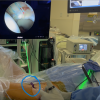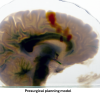Research
 Professor Victor Bright, Professor Emeritus Alan Greenberg and PhD student Mo Zohrabi have helped develop a laser-based imaging method called stimulated Raman scattering to improve the performance of desalination plants by allowing real-time detection of membrane fouling. The advance could help make desalination more efficient and reliable as global demand for clean water rises.
Professor Victor Bright, Professor Emeritus Alan Greenberg and PhD student Mo Zohrabi have helped develop a laser-based imaging method called stimulated Raman scattering to improve the performance of desalination plants by allowing real-time detection of membrane fouling. The advance could help make desalination more efficient and reliable as global demand for clean water rises. PhD student Laura Shannon, alongside Professors Greg Rieker and Peter Hamlington are setting fires inside wind tunnels to gain a better understanding of how fire spreads across different terrain. The team says their findings could help keep communities safer in a world where climate-driven wildfire is becoming more common—and more dangerous.
PhD student Laura Shannon, alongside Professors Greg Rieker and Peter Hamlington are setting fires inside wind tunnels to gain a better understanding of how fire spreads across different terrain. The team says their findings could help keep communities safer in a world where climate-driven wildfire is becoming more common—and more dangerous. Soil is comprised of an intricate network of bacteria and other microbes that humans depend on, but this complex environmental system is constantly shifting, making it difficult for scientists to measure. Associate Professor Gregory Whiting and his team of researchers are developing reliable, inexpensive and easy-to-deploy sensors that monitor soil in real time to help farmers optimize their use of fertilizers, reduce greenhouse gas emissions and save money in the process.
Soil is comprised of an intricate network of bacteria and other microbes that humans depend on, but this complex environmental system is constantly shifting, making it difficult for scientists to measure. Associate Professor Gregory Whiting and his team of researchers are developing reliable, inexpensive and easy-to-deploy sensors that monitor soil in real time to help farmers optimize their use of fertilizers, reduce greenhouse gas emissions and save money in the process. Assistant Teaching Professor James Harper recently led a behavioral study analyzing toilet use in Cambodia. Their goal was to introduce a new, smart toilet design that can keep rural households safe and protect the environment. But while households reported that they liked the new system, a crucial piece was missing: using it correctly.
Assistant Teaching Professor James Harper recently led a behavioral study analyzing toilet use in Cambodia. Their goal was to introduce a new, smart toilet design that can keep rural households safe and protect the environment. But while households reported that they liked the new system, a crucial piece was missing: using it correctly. Research Professor Jacob Segil collaborated with Dr. Omer Mei Dan from the University of Colorado Anschutz School of Medicine to create a redesigned surgical instrument called the CAP-LIFT cannula. The device was recently launched in October, and within the first few weeks used in over 100 successful surgeries.
Research Professor Jacob Segil collaborated with Dr. Omer Mei Dan from the University of Colorado Anschutz School of Medicine to create a redesigned surgical instrument called the CAP-LIFT cannula. The device was recently launched in October, and within the first few weeks used in over 100 successful surgeries. Professor Victor Bright and mechanical engineering PhD students Eduardo Miscles and Mo Zahrabi have recently collaborated on a new study that demonstrates how a fluid-based optical device known as an electrowetting prism can be used to steer lasers at high speeds for advanced imaging applications.
Professor Victor Bright and mechanical engineering PhD students Eduardo Miscles and Mo Zahrabi have recently collaborated on a new study that demonstrates how a fluid-based optical device known as an electrowetting prism can be used to steer lasers at high speeds for advanced imaging applications. Assistant Professor Robert MacCurdy and fourth-year PhD student Charles Wade have created an open-source design system software package that uses functions and code to map not just shapes, but where different materials belong in a 3D object. The project, called OpenVCAD, has the potential to transform 3D printing by enabling engineers to design multi-material objects smarter and more efficiently.
Assistant Professor Robert MacCurdy and fourth-year PhD student Charles Wade have created an open-source design system software package that uses functions and code to map not just shapes, but where different materials belong in a 3D object. The project, called OpenVCAD, has the potential to transform 3D printing by enabling engineers to design multi-material objects smarter and more efficiently. The Paul M. Rady Department of Mechanical Engineering at CU Boulder is welcoming five new faculty members this fall semester. From responsive biomaterials and unique teaching environments to additive manufacturing, these talented scientists and engineers bring a wealth of knowledge and passion to our teaching and research missions.
The Paul M. Rady Department of Mechanical Engineering at CU Boulder is welcoming five new faculty members this fall semester. From responsive biomaterials and unique teaching environments to additive manufacturing, these talented scientists and engineers bring a wealth of knowledge and passion to our teaching and research missions. Rising senior Alex Hansen spent his summer break in CU Boulder’s Summer Program for Undergraduate Research (SPUR) studying the consequences of methane emissions. His work analyzing data gathered from unique methane detection sensors can one day help researchers address the methane crisis at some of the world's most prevalent methane emissions sites.
Rising senior Alex Hansen spent his summer break in CU Boulder’s Summer Program for Undergraduate Research (SPUR) studying the consequences of methane emissions. His work analyzing data gathered from unique methane detection sensors can one day help researchers address the methane crisis at some of the world's most prevalent methane emissions sites. Professor Sean Humbert is one of many CU Boulder faculty members making important artificial intelligence (AI) discoveries. With the help of his lab group and other CEAS collaborators, Humbert is developing algorithms and autonomous systems that can process sensor data within milliseconds to operate in places and situations where direct human engagement creates unacceptable risk.
Professor Sean Humbert is one of many CU Boulder faculty members making important artificial intelligence (AI) discoveries. With the help of his lab group and other CEAS collaborators, Humbert is developing algorithms and autonomous systems that can process sensor data within milliseconds to operate in places and situations where direct human engagement creates unacceptable risk.

